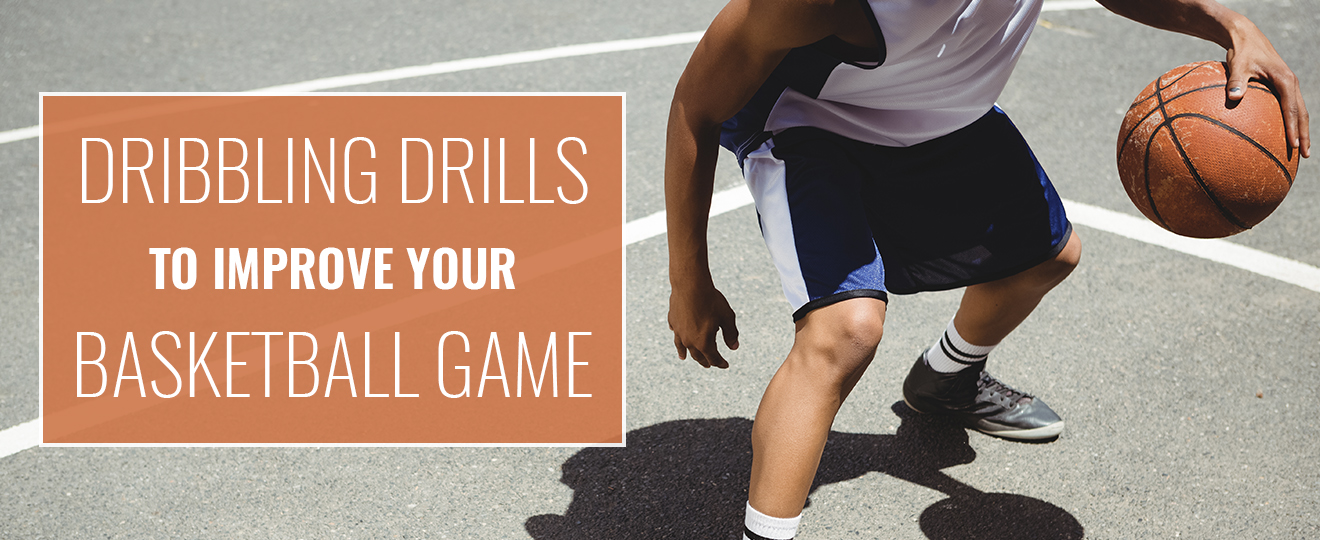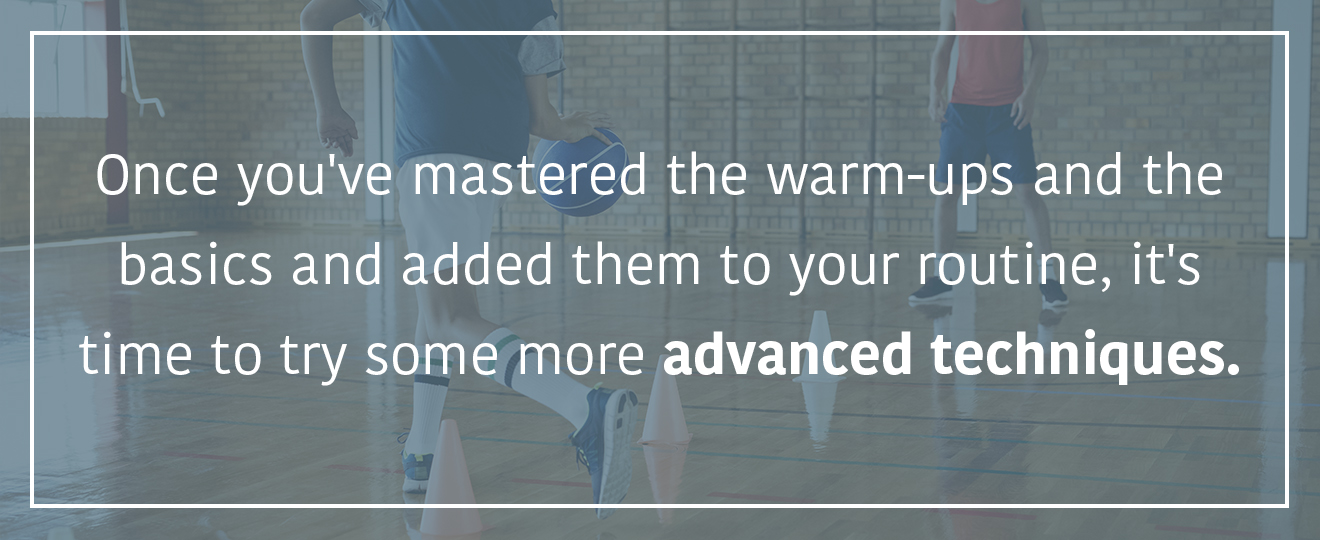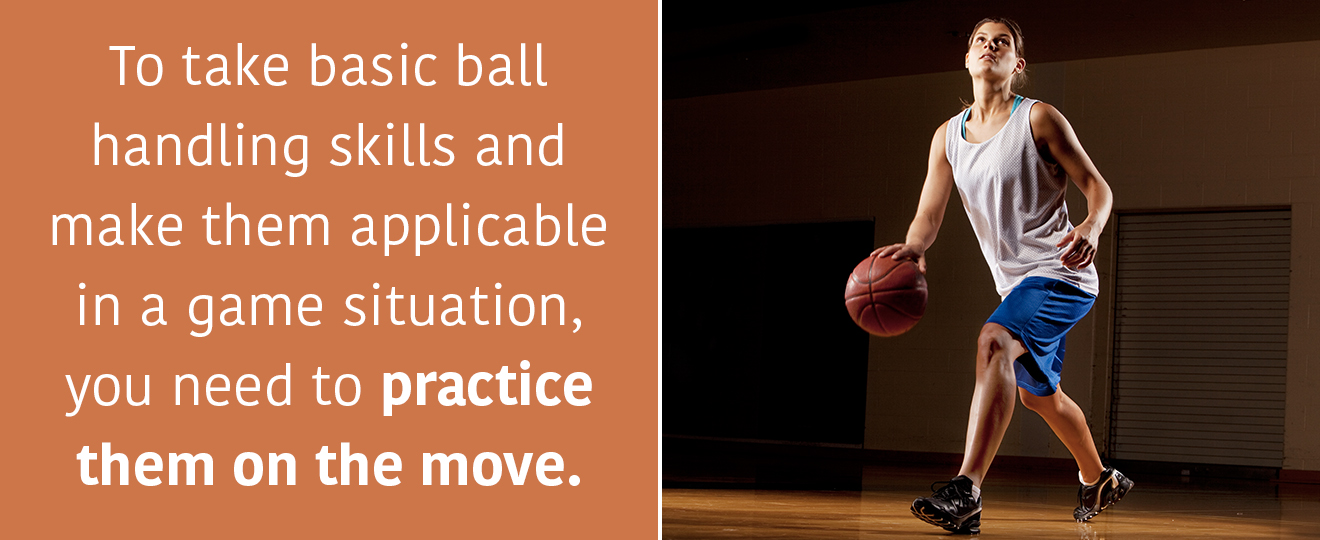
Dribbling is arguably the most important part of basketball — second only perhaps to shooting. But while shooting may be the end goal of the sport, dribbling is the foundation upon which everything else depends.
Without dribbling, there is no movement. There are no drives to the basket, no lay-ups, no quick fake-outs or skillful maneuvers. It is often the player’s only tool to advance toward the basket.
That’s why you should see dribbling as a rudimentary skill where no amount of practice is too much. Because it’s feeling-based, perfecting dribbling is only possible with repetition. You really need to get to know the weight and behavior of a basketball in your hands. The great news is you can perform any of the following exercises at your own home court so you need nothing more than a residential space to improve your touch. Here we explain drills that will improve your touch, agility and confidence in handling the ball.
Part 1: Warm-Ups
Warming up is much more than a way to get your muscles ready for action — it also gets your “touch” back after spending hours, days or more away from the sport. Basketball is all about the ability to know and control the ball, and this is the step where you help your fingers remember their bag of skills.
1. Ankle Loops
Many warm-up drills involve passing the ball from hand to hand, focusing on your fingers’ role in propelling it between them. This drill takes this idea and adds your legs into the equation, helping you wake up your body’s sense of spacial awareness. Begin by placing your feet a bit wider than shoulder length apart. Crouch into the squatting position and pass the ball in a figure eight around the outside of your right ankle, between your legs, around the outside of your left ankle, between your legs, and so on.
You should perform this drill in one fluid motion without looking at the ball. Remember, you always want to have a feel for where the ball is as it leaves one hand and goes to the other. Practicing this every day at your home court will really up your level of play.
2. Full-Body Loops
This exercise involves passing the ball between your hands at different heights, forcing your arms to adopt different angles and positions in their movement. Start by passing the ball around your head, switching directions every few times to avoid one hand growing too dominant. Do the same around your chest, your waist and your knees. Then pass the ball around the outside of your legs, ending in the same exercise as before — the figure eight.
Why do this warm-up? All too often players warm up their dribbling by focusing on handling the ball near the floor, which is where more aggressive maneuvering takes place. It is essential to grow comfortable with the ball at every height.
3. The Straddle Flip
To do this warm-up, stand in the shoulder-width squat position and hold the ball in front of you with one hand. It should be about knee level. Flick the ball backward between your legs, popping it upward a bit, and bring the same hand around your body to catch it behind you before it hits the ground. Then do the exercise in reverse: flick the ball forward between your legs and catch it in front with the same hand.
This exercise allows you to predict the location of the ball when fast thinking is needed. Having to whip your arm around to catch it on the other side of your body forces you to practice split-second timing and agility, which comes into play when a pass catches you off guard or when a player makes a jab at your dribbling, forcing you to catch and recover the ball before you lose control.
Part 2: Basic Dribbling Drills
Remember, dribbling is the foundation of the house that is basketball. Without a good foundation, the whole structure crumbles.
Many novice players skip practicing the basics. After all, if you have mastered behind-the-back and between-the-legs dribbling, why would you waste time bouncing the ball straight up and down in front of you? The answer goes straight to that foundation analogy — by always making sure you run the basics, you stay on top of the subtle mechanics of dribbling and ensure nothing gets sloppy without you noticing.
As you work on fundamental dribbling skills, start including shooting in your routine. It helps improve on-the-spot thinking and also makes doing drills more fun. You can use either an in-ground or wall-mounted hoop for shooting, depending on where you live and wish to play. Let’s look at a few basic drills that will help you stay razor-sharp in our dribbling game.

1. The Uber-Basics: Standing vs. Running and Single vs. Double-Handed
With all of these basic dribbling drills, remember you are looking for proper technique above all else. That means:
- Keeping your eyes up and not on the ball
- Having your butt and legs in the squat position
- Making sure your chest stays up
If you are just starting out, this may feel unnecessary and awkward, but trust it is for the best and will always serve you well.
Also, remember to dribble the ball as hard as you can. This helps you learn to control the ball. It also keeps it moving quickly and makes it harder for an opponent to swipe it away from you, while simultaneously conditioning you and making you appear more formidable on the court. You don’t need much space to ensure you are using strong hands while working with the ball, and this can be done in your home driveway or any quiet residential street.
Start by standing in one spot and dribbling single-handedly. You should be able to dribble with either hand without looking at the ball. Test yourself by thinking about other things or trying to talk while dribbling — this is a good simulation of distractions during the game.
Next, stand still and dribble the basketball between your hands. You can alternate between one and two bounces per hand. Again, make sure you are not relying on your eyes to keep track of the ball’s position. That information should be available from your fingers alone.
Finally, practice the basic single and double-handed dribbles while jogging and running. Running introduces lots of vertical and horizontal motion to our bodies, which results in more difficulty keeping track of the ball.
2. Crossover
Much of dribbling is finding ways to get past your opponent. The crossover is a very effective means of doing so, though the majority of the technique lies in your stance and body language. To practice the crossover, imagine you are squaring off against an opponent. To get past him or her, you want to dribble the ball from one hand to the other and then take off to that side.
The trick here lies in your shoulders and hips. As you dribble the ball from your right hand to the left, rotate your hips and shoulders in the same direction as the ball’s movement. You can also step forward with your right leg. This body movement protects the ball from your opponent, shielding it as you move. Practice this drill until it is fluid and fast, and remember not to give away what you’re about to do by leading with your head.

3. Figure Eight Dribbles
There’s no doubt that a figure eight is more than just flash. The ability to make the ball vanish between our legs and behind our backs opens up the door for lots of quick plays and evasive maneuvers. This drill, however, takes it a bit further than the standard figure eight dribble.
First, work on the classic figure eight. This is exactly like the first warm-up exercise, except you are now bouncing the ball as it passes between your legs. Try this a variety of ways, from bouncing it continuously as it travels its course to letting it bounce only once as it passes between your legs.
Second, try doing a figure eight dribble using only your right hand. This exercise requires a low stance, which is helpful for guarding the ball against opponents. It also requires quick reflexes and the ability to move your arms quickly from front to back and vice versa. Switch directions and make sure you’re equally comfortable with both. Then repeat the exercise with your left hand.
4. The Kill
It’s not quite as dramatic as it sounds, but the kill is a technique that comes in handy when you’re trying to outwit an opponent and maintain the element of surprise:
- Dribble regularly with one hand, bouncing the ball up to waist height or higher.
- Then suddenly reach down to intercept the ball just after its bounce, when it is several inches off the ground.
- Begin rapidly dribbling it at this height.
This move, stopping the ball mid-bounce and constraining it to a low, aggressive dribble, is what is known as the “kill.” Repeat with each hand. How does the kill aid you in a real game? Remember, to get around an opponent, going low and fast is often the best way to make your attack. It surprises them and makes the ball more inaccessible by minimizing the amount of time it is out of your hand.
Part 3: Advanced Dribbling Drills
Once you’ve mastered the warm-ups and the basics and added them to your routine, it’s time to try some more advanced techniques. These drills require a lot of practice to get right, and, in some cases, you’ll find you need a good amount of conditioning as well.

1. Two-Ball Dribble
Dribbling well is kind of like playing the drums. You need all different limbs working independently and yet somehow together, to make it fluid and smooth. This exercise works on your ability to get your two hands working separately. You will need two basketballs.
To start, begin dribbling one basketball in each hand, bouncing them waist-high simultaneously and making sure to put some muscle into them. Then, while keeping the same rhythm and height in one hand, lower the other hand slowly toward the ground until you are aggressively dribbling several inches from the floor. Hold this position for half a minute, then return the ball to the same height as the other and switch sides.
This exercise is challenging and takes a good bit of practice to perfect. But when you have it, take pride in knowing your hand is learning to control the ball with the ultimate distraction — the other hand dribbling another ball at a different speed.
2. The Jab Dribble
Yet another tool in tricking your opponent, the jab dribble is a fast move that suggests you will move in one direction but is actually a fake-out. Start dribbling with your right hand and with your feet in a wide stance. With your left foot, step forward and to the left while simultaneously palming the ball in that direction at the top of its bounce. This gives the impression you are about to take off to the left.
Your left foot lands and “jabs” you back to the right. Your right hand, meanwhile, whips the ball back down and to the right, thereby giving you the opportunity to move in that direction. The goal is to get your opponent’s momentum moving to the left, and just when they commit to moving in that direction, you change back and get around them.
3. Behind the Back and Between the Legs
To take basic ball handling skills and make them applicable in a game situation, you need to practice them on the move. That means taking that ability to pass the ball between your legs and behind your back and being able to apply it confidently while advancing forward.
To start, set out some cones or markers every three feet or so. This will give you a useful guide for timing and spacing. Step forward with one leg, and with the opposite hand, pass the ball through your legs and catch it with the other hand. Then step forward with the other leg and perform the mirror image of this move, which leads you to the same position you started in.
Similarly, lunge forward and dribble the ball from one hand to the other behind your back. Dribble once or twice with that hand, then step forward and pass it back to the original hand again behind your back. Focus on steadiness and flow. The cones are there to help establish a rhythm. With each type of dribbling, make sure the critical bounce — that is, the behind-the-back or between-the-legs bounce — occurs once per cone.

4. Chair Practice
Using a chair to simulate an opponent is an excellent way to work on your pacing and attack while dribbling. One of the best exercises involves setting up a chair near the three-point line. Charge the chair while dribbling, as if you might go to the left of the chair. Then perform a crossover and run to the right of the chair, driving toward the basket for a layup.
The Overall Goal of Dribbling Drills
When you’re intimately acquainted with the basics, you stay sharp. That’s why having a good set of dribbling drills is crucial. When you incorporate shooting into the routine, you’re practicing like the pros.
Need a basket like the pros? You can do so in your own home or driveway! PROformance offers top-of-the-line basketball hoops, featuring shatterproof backboards, corrosion-proof steel supports, a premium pier-mount anchor system, a dual-spring safety breakaway rim and much more. For a hoop that will stand the test of time and every test of endurance you throw its way, check out the catalog at PROformance Hoops.
